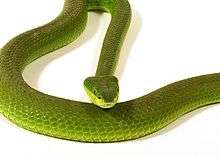Trimeresurus erythrurus
Trimeresurus erythrurus, commonly known as the red-tailed bamboo pitviper,[3] is a venomous pit viper species endemic to India, Bangladesh and Burma. No subspecies are currently recognized.[4]
| Trimeresurus erythrurus | |
|---|---|
 | |
| Scientific classification | |
| Kingdom: | Animalia |
| Phylum: | Chordata |
| Class: | Reptilia |
| Order: | Squamata |
| Suborder: | Serpentes |
| Family: | Viperidae |
| Genus: | Trimeresurus |
| Species: | T. erythrurus |
| Binomial name | |
| Trimeresurus erythrurus (Cantor, 1839) | |
| Synonyms | |
| |
Description
Males grow to a maximum total length 575 millimetres (22.6 in), of which the tail is 120 millimetres (4.7 in) in length. Females reach a maximum total length of 1,045 millimetres (41.1 in), with a tail length of 165 millimetres (6.5 in).[5]
Scalation: dorsal scales in 23-25 longitudinal rows at midbody; first upper labial partially or completely fused to nasal; 9-13 upper labials, 1-2 rows of scales separate upper labials from the suboculars; 11-14 scales in a line between supraoculars; supraoculars rarely divided; temporal scales small, strongly keeled; ventral scales: males 153-174, females: 151-180; subcaudals: males 62-79, females 49-61, usually paired, occasionally unpaired shields present among paired series.[5]
Color pattern: head uniform green, dorsum bright green, light ventrolateral stripe present in males, present or absent in females (Maslin [1942:23] says that the ventrolateral stripe is absent, but M.A. Smith [1943:523] states that it is present in males and variable in females), tail spotted with brown; hemipenes without spines.[5]
Geographic range
Found in eastern India (Assam, Manipur, Mizoram, Sikkim), Bangladesh, Burma. The original type locality given was as "Delta Gangeticum" (Ganges Delta, West Bengal State, eastern India). The type locality given by Boulenger (1896) is "Ganges Delta."[1]
References
- McDiarmid RW, Campbell JA, Touré T. 1999. Snake Species of the World: A Taxonomic and Geographic Reference, Volume 1. Herpetologists' League. 511 pp. ISBN 1-893777-00-6 (series). ISBN 1-893777-01-4 (volume).
- The Reptile Database. www.reptile-database.org.
- Gumprecht A, Tillack F, Orlov NL, Captain A, Ryabov S. 2004. Asian Pitvipers. GeitjeBooks. Berlin. 1st Edition. 368 pp. ISBN 3-937975-00-4.
- "Trimeresurus erythrurus". Integrated Taxonomic Information System. Retrieved 27 September 2006.
- Leviton AE, Wogan GOU, Koo MS, Zug GR, Lucas RS, Vindum JV. 2003. The Dangerously Venomous Snakes of Myanmar, Illustrated Checklist with Keys. Proc. Cal. Acad. Sci. 54 (24): 407-462.
Further reading
- Cantor, T.E. 1839. Spicilegium serpentium indicorum [parts 1 and 2]. Proc. Zool. Soc. London, 7: 31-34, 49-55.
- Cantor, T.E. 1840. Spicilegium Serpentium Indicorum. Ann. Mag. Nat. Hist. (1) 4: 271-279.
- Gumprecht, A. 2001. Die Bambusottern der Gattung Trimeresurus Lacépède Teil IV: Checkliste der Trimeresurus-Arten Thailands. Sauria 23 (2): 25-32.
- Maslin, T. Paul. 1942. Evidence for the Separation of the Crotalid Genera Trimeresurus and Bothrops, with a Key to the Genus Trimeresurus. Copeia 1942 (1): 18-24.
- Smith, M.A. 1943. The Fauna of British India, Ceylon and Burma, Including the Whole of the Indo-Chinese Sub-region. Reptilia and Amphibia. Vol. III.—Serpentes. Secretary of State for India. (Taylor and Francis, Printers). London. xii + 583 pp. (Trimeresurus erythrurus, pp. 522–523.)
- Toriba, Michihisa. 1994. Karyotype of Trimeresurus erythrurus. Snake 26 (2): 141-143.
External links
- Trimeresurus erythrurus at the Reptarium.cz Reptile Database. Accessed 17 November 2012.
